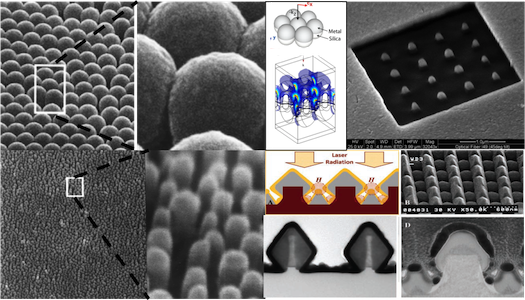
In 1984, our laboratory first reported the general applicability of SERS as an analytical technique, and demonstrated that the SERS phenomenon is in fact a general effect that can be applied to a wide variety of chemicals including polyaromatic compounds [Analytical Chemistry, 56: 1667 (1984)]. We first introduced the use of metal film on nanostructures (MFON) as efficient and reproducible plasmonics-active media. Our SERS nanoplatforms have involved metal film on nanospheres, referred to ‘nanowave’ (Fig. top left), nanorods (bottom left), nanodots (top right), nanowires and nanodiamonds chips (bottom right). The development of these plasmonics-active substrates has led to a wide variety of SERS platforms for chemical sensing, bioanalysis and biosensing, chemical analysis, medical diagnostics and therapy.
Read more
- H.T. Ngo, H-N Wang, T. Burke, G.S. Ginsburg, T. Vo-Dinh “Multiplex detection of disease biomarkers using SERS molecular sentinel-on-chip” Analytical and Bioanalytical Chemistry, 406 (14), 3335-3344 (2014)
- T. Vo-Dinh, A. M. Fales, G.D. Griffin, C. G. Khoury, Y. Liu, H. Ngo, S. J Norton, J. K. Register, H. N. Wang, H. Yuan “Plasmonic nanoprobes: from chemical sensing to medical diagnostics and therapy”, Nanoscale, 5, 10127-10140 (2013)
- H. T. Ngo, H. N.Wang, A. Fales, and T. Vo-Dinh “Label-free DNA Biosensor Based on SERS Molecular Sentinel on Nanowave Chip”, Anal. Chem., 85, 6378–6383 (2013)
- C. Khoury and T. Vo-Dinh “Plasmonic Nanowave Substrates for SERS: Fabrication and Numerical Analysis", J. Phys. Chem. C, 116, 7534-7545 (2012)
- P. D. Enlow, M. Buncick, R. J. Warmack, and T. Vo‑Dinh "Detection of Nitro‑polynuclear Aromatic Compounds by Surface‑Enhanced Raman Spectroscopy" Anal. Chem., 58, 1719 (1986).
- T. Vo Dinh, M.Y.K. Hiromoto, G. M. Begun, and R. L. Moody "Surface-Enhanced Raman Spectroscopy for Trace Organic Analysis" Anal. Chem., 56: 1667 (1984).
